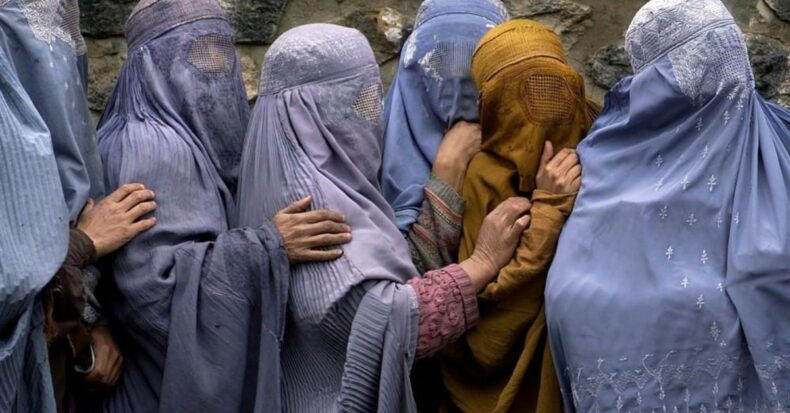With efforts to improve the status of women in Afghanistan followed by moves to roll them back, their rights have always been a subject of debate and conflict in the war-torn country.
As the Taliban took over Kabul on August 15, rights advocates think it will bring back darker days for women and girls in Afghanistan. Even though the outfit has assured that it has moderated its approach this time, their actions say something opposite.
There are no women in the outfit’s cabinet. Male and female students will be allowed to attend university in gender-segregated classes, and they will only follow the Islamic dress code. Men are ‘warned’ not to sport “foreign-looking” hairstyles and beards that are too short.
In the last week of September 2021, the Taliban ordered boys and male teachers to retreat to school and resume secondary classes. This order did not include girls of the same age group.
Women under the monarchy:
When Amanullah Khan became the King of Afghanistan in 1926, he pushed for more modernised social reforms. Like his counterparts, Kemal Ataturk in Turkey and Mohammad Reza in Iran, he proclaimed a constitution that guaranteed equal rights to women and men.
King Amanullah Khan, 17th Emir of Afghanistan and 1st king of Afghanistan. He was the first to introduce reforms that gave women equal rights as men.

His social reforms included a new dress code that permitted women to remove their veils and encouraged officials to wear European dresses.
Queen Soraya, Amanullah’s wife, became the face of women’s rights in Afghanistan. She opened the first girls’ school in Kabul. Under her influence, Amanullah banned child marriage and polygamy.
However, this modern approach of Amanullah did not sit well with Afghan traditionalists. The king eventually had to flee.
In 1933, Zahir Shah became the king of Afghanistan and remained at the throne for four decades. He cautiously reintroduced most of Amanullah’s reforms.
In 1953, when General Mohammad Daud became the Prime Minister under the monarchy of Zahir Shah, he also introduced some social reforms such as the abolition of purdah (the practise of secluding women from society.)
In 1964, women helped introduce a constitutional monarchy wherein they had the right to vote and allowed them to seek elected offices. Women were working, running businesses, and entering politics. The fight with traditionalists never ended, though.

After the monarchy:
In 1979, Mohammad Daud was killed in a pro-Soviet coup. The Soviet Union invaded the nation and installed the communist regime.
The country then descended into a civil war between the communist troops and their rival, the Islamist fighters called Mujahideen, where women’s status began to erode. Mujahideens were backed by China, the US, Saudi Arabia, Iran, and Pakistan to supply them with arms.
By 1985, half of Afghanistan’s population was estimated to have flown to neighbouring Iran or Pakistan due to continuous wars.
The Mujahideens, in a quest to defeat Communism, attacked NGOs in Pakistan refugee camps promoting girls’ education and women’s literacy and employment.
During the reign of Taliban 1.0:
After the Soviet-Afghan war ended, the Mujahideens split, and the Taliban gained the upper hand in the 1990s. They officially came to power in 1996 and stayed in power till 2001.
During their regime, they imposed hardline Islamic rules that restricted the lives of Afghan women ultimately. Their education was prohibited in areas controlled by the authority.
After the outfit took control of Kabul, women over Afghanistan were banned from attending schools, working, speaking in public, or even going out of their house without a male member.
Those who didn’t abide by the Taliban’s rules were either lashed in public or stoned to death. The suicide rate among women rose drastically.
Their access to healthcare also dropped as they could only go to a women-only hospital. But that was also a rarity because women were hardly allowed to work. Women were forced to cover themselves in a burqa, a one-piece garment covering the entire head and body.
The US invasion:
When the Taliban leadership fled in 2001, the United States undertook the mission to rebuild the war-torn nation. It focused on improving the lives of Afghan women and girls. In 2004, when the nation adopted the constitution, it guaranteed rights and quotas to women.
They were trained to become surgeons, pilots, judges, and prosecutors. They were also part of the Army and took part in the political process.
The Taliban 2.0:
After 20 years of fighting the Taliban, NATO and the US forces withdrew their troops leaving women and the whole nation in a state of compunction.
Even though the outfit promotes itself in a softer image, they have clearly said that they will respect women’s rights according to Sharia law.
Most rights advocates say that Taliban 2.0 is just like Taliban 1.0.
Women are protesting for their rights this time as well. The Taliban has converted the Ministry of Women’s Rights to the Ministry of Propagation of Virtues and Prevention of Vices, and IT has also banned women from playing sports.













